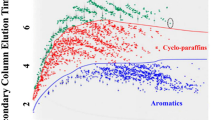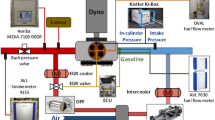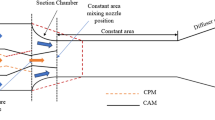Abstract
An experimental study was conducted to examine the effect of injection pressure and fuel type on the spray tip penetration length and the angle of spray injected into atmospheric chamber. The objective of the present study is to formulate empirical correlations of the spray tip penetration and the spray angle for non-evaporative condition. The experiment was performed by a common rail type high-pressure injector for the diesel engine at the injection pressure 40∼100 MPa and four different fuels (D100, BD25, BD45, and BD65). The results showed that the biodiesel content increased the spray tip penetration and decreased the spray angle. The correlation of spray tip penetration is expressed for each region before and after spray break-up time in terms of injection pressure, fuel viscosity and time after start of injection. The correlation is also obtained for spray angle equation terms of injection pressure and fuel viscosity.
Similar content being viewed by others
References
H. Hiroyasu and M. Arai, Structures of fuel sprays in diesel engine, SAE Technical Paper Series, 900475 (1990).
J. D. Naber and D. L. Siebers, Effects of gas density and vaporization on penetration and dispersion of diesel sprays, SAE Technical Paper Series, 960034 (1996).
J. Arregle, J. V. Pastor and S. Ruiz, The influence of injection parameters on diesel spray characteristics, SAE Technical Paper Series, 1999-01-00200.
C. Baumgarten, Mixture formation in internal combustion engine, Springer (2006).
A. H. Lefebvre, Atomization and sprays, Hemisphere Publishing Co. (1989).
S. Gupta, R. Poola and R. Sekar, Effect of injection parameters on diesel spray characteristics, SAE Technical Paper Series, 2000-01-1600 (2000).
R. Morgan, J. Wray, D. A. Kennaird, C. Crua and M. R. Heikal, The influence of injector parameters on the formation and break-up of a diesel spray, SAE Technical Paper Series, 2001-01-0529 (2001).
C. S. Bae, J. Yu, J. S. Kang, J. S. Kong and K. O. Lee, Effect of nozzle geometry on the common-rail diesel spray, SAE Technical Paper Series, 2002-01-1625 (2002).
S. S. Sazhin, G. Feng and M. R. Heikal, A model for fuel spray penetration, Fuel, 80 (2001) 2171–2180.
K. K. Song, S. C. Sim, B. K. Jung, H. G. Kim and J. H. Kim, Effect of injection parameters on diesel spray characteristics, J Mech Sci Technol, 19(6) (2005) 1321–1328.
G. Yuan, D. Jun, L. Chunwang, D. Fengling, L. ZHuo, W. Zhijun and L. Liguang, Experimental study of the spray characteristics of biodiesel based on inedible oil, Biotechnology Advance, 27 (2009) 616–624.
J. K. Hyung, H. P. Su and S. L. Chang, A study on the macroscopic spray behavior and atomization characteristics of biodiesel and dimethyl ether under increased ambient pressure, Fuel process technol, 91 (2009) 354–363.
C. S. Lee and S. W. Park, An experimental and numerical study on fuel atomization characteristics of high-pressure diesel injection sprays, Fuel:, 81 (2002) 2417–2423.
S. H. Park, H. J. Kim and C. S. Lee, Comparison of experimental and predicted atomization characteristics of highpressure diesel spray under various fuel and ambient pressure, J Mech Sci Technol, 7 (2010) 1491–1499.
J. Shao, Y. Yan, G. Greeves and S. Smith, Quantitative characterization of diesel sprays using digital imaging techniques, Meas. Sci. Technol. 14 (2003) 1110–1116.
E. Delacourt, B. Desmet and B. Besson, Characterization of very high pressure diesel sprays using digital imaging techniques, Fuel, 84 (2005) 859–867.
J. D. Ryu, H. M. Kim and K. H. Lee, A study on the spray structure and evaporation characteristic of common rail type high pressure injector in homogeneous charge compression ignition engine, Fuel, 84 (2005) 2341–2350.
H. K. Suh and C. S. Lee, Experimental and analytical study on the spray characteristics of dimethyl ether (DME) and diesel fuels within a common-rail injection system in a diesel engine, Fuel, 87 (2008) 925–932.
A. Ghurri, J. D. Kim, K. K. Song, J. J. Jung and H. G. Kim, Qualitative and quantitative analysis of spray characteristics of diesel and biodiesel blend on common-rail injection system, J Mech Sci Technol, 25(4) (2011) 885–893.
Author information
Authors and Affiliations
Corresponding author
Additional information
Recommended by Associate Editor Kyoung Dong Min
Ainul Ghurri received the B.S. degree in mechanical engineering from Brawijaya University, Indonesia in 1995 and master degree in mechanical engineering from Indonesia University, Indonesia in 1998, respectively. He is a lecturer at mechanical engineering department of Udayana University, Indonesia. He is currently a Ph.D. student in Precision Mechanical Engineering Department of Chonbuk National University, Jeonju, South Korea. His research interests are in the area of fuel spray characteristics, biodiesel fuel, and its engine performance and emissions characteristics.
Jae-Duk Kim received the B.S. and M.S. degrees in Precision Mechanical Engineering from Chonbuk National University, South Korea in 2009 and 2011. He is currently a Ph.D. student in Precision Mechanical Engineering Department of Chonbuk National University. His research interests include fuel spray injection characteristics, and diesel engine performance and emission characteristics.
Hyung Gon Kim received the B.S. and M.S. degrees in Precision mechanical Engineering from Chonbuk national University, Korea in 1995 and 1997; the Ph.D. degree from Kagoshima University, Japan in 2006. He currently works as an adjunct professor in Chonbuk National University. His current research interests are heat and fluid engineering, atomization system, and agricultural machinery.
Jae-Youn Jung received the B.S. and M.S. degree in mechanical engineering from Chonbuk National University, South Korea and Ph.D. degree from Tokyo Institute of Technology, Japan. He is currently a professor at Precision Mechanical Engineering Department, Chonbuk National University. His major research field includes tribology, hydraulic pump and motor design, and its performance improvement.
Kyu-Keun Song received the B.S. and M.S. degree in mechanical engineering from Chonbuk National University, South Korea and Ph.D. degree in mechanical engineering from Hokkaido University, Japan. He is currently a professor at Precision Mechanical Engineering Department, Chonbuk National University. His research interests include combustion and exhaust emission characteristics of diesel engine, spray characteristics of biodiesel in common rails injection system.
Rights and permissions
About this article
Cite this article
Ghurri, A., Kim, JD., Kim, H.G. et al. The effect of injection pressure and fuel viscosity on the spray characteristics of biodiesel blends injected into an atmospheric chamber. J Mech Sci Technol 26, 2941–2947 (2012). https://doi.org/10.1007/s12206-012-0703-1
Received:
Revised:
Accepted:
Published:
Issue Date:
DOI: https://doi.org/10.1007/s12206-012-0703-1




